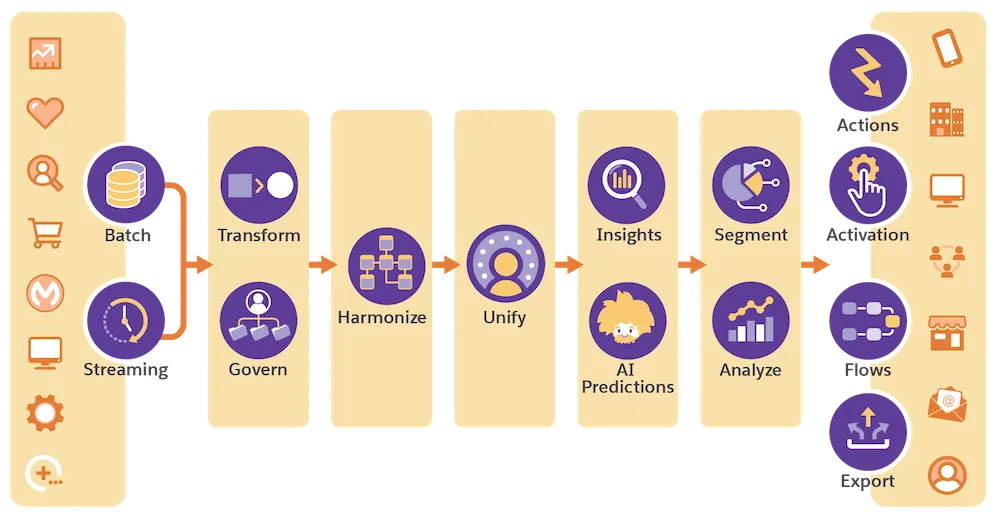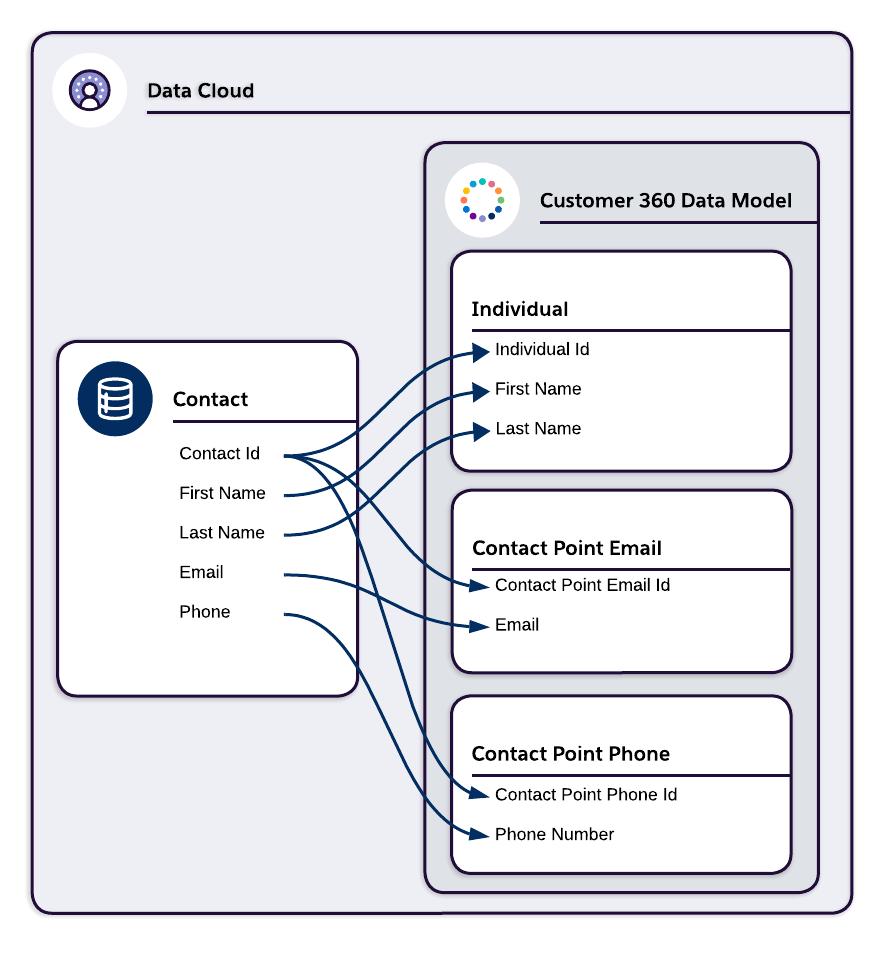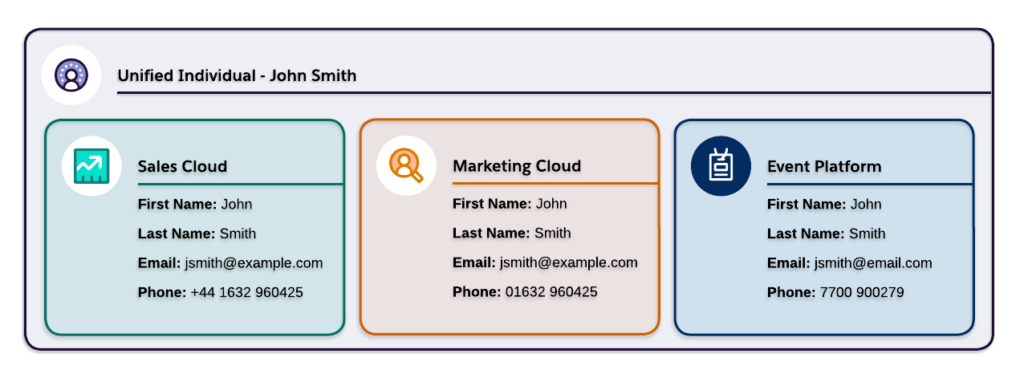Look at the bunny! Customer 360! Real-time! Artificial Intelligence! All of these messages fizz around Data Cloud, but what does it really mean for your business? In this article, we look behind the buzzwords and get real with the capabilities and use cases for Data Cloud.
What do Salesforce say about Data Cloud?
Salesforce are so excited about Data Cloud that they’re giving away a limited-use version for free. You can read more about that in our blog Salesforce Announces Free Data Cloud and Tableau. Here’s what they have to say about the product in general:
Salesforce’s Data Cloud revolutionizes the Customer 360 experience, enabling businesses to craft enchanting real-time experiences effortlessly. This hyperscale data engine unifies customer data, enterprise content, telemetry data, Slack conversations, and other data types, cultivating a comprehensive customer profile. This empowers businesses across industries to deliver intelligent, automated experiences, fostering customer loyalty, reducing expenses, and quickly boosting ROI.
What’s new here?

Salesforce has a great way of storing your customer CRM data. However, as in all things, there are trade-offs. The data model is perfect for some purposes, and not so perfect for others.
With the release of Data Cloud, Salesforce has designed what it refers to as the Customer 360 Data Model. This has been designed to standardise your data into three key categories:
- Profile Data – Information about a person. For example, their name, email address, a device such as a laptop or identification such as a passport.
- Engagement Data – Things a person does, such as purchasing a product or clicking the link in an email.
- Other Data – This is data that supports the first two categories. For example, your engagement data could tell you an individual purchased a product. The product list would count as “Other Data” and could be used to enhance the information about a purchase with extra information.
Bringing in data from multiple sources and aligning it with the Customer 360 Data Model allows you to have a more flexible data structure. Whatever the data source, once we map it to the 360 Model, we can use all of that data together in harmony.
Unlike a data warehouse, which is designed with a focus on reporting, Data Cloud is built with data usage in mind. This allows you to bring customer data from across your business into a single place and harmonise it. This means that all data types can be treated the same and that, ultimately, you can identify unique individuals and create a unified profile for each.
With your unified individuals, you can build reports, run AI predictions, segment your data, add context to your CRM, and automate processes in multiple applications.
Ingestion – Gathering data from across your business

Data Cloud does not solve the problem of connecting systems and ingesting data for you. It’s not Mulesoft!
Where existing connectors are available, ingestion into Data Cloud is simple. It is also extensible for other systems. Salesforce hopes to create a marketplace of connectors for common systems, expanding the number that fall into the category of “easy”.
Salesforce Clouds
Data Cloud can easily connect to Marketing Cloud, B2B Commerce Cloud, and Salesforce CRM with pre-packaged bundles. These bundles bring in the data and map it into the Customer 360 Data Model. As you would hope, this means you can start getting value really fast from these data sources.
Cloud Storage and SFTP
Data Cloud can easily read from CSV files. The files can be stored on Amazon S3, Azure, Google Cloud or SFTP. In these cases, you will need to map the data model yourself, but this can be done with clicks, not code. This can be great for systems that do daily dumps of transaction data
Web And Mobile
Data Cloud can also receive data from SDKs on mobile and web. These direct connections will require you to use their SDK, but other options are possible, e.g. Google Analytics → Google Cloud → Data Cloud or Google Analytics → Marketing Cloud → Data Cloud
Everything Else
Other connections are made using either Mulesoft or custom integrations which call the Data Cloud Ingestion API. This means that almost anything can be brought into Data Cloud if you are willing to put in the work.
These other connections (Data Streams) are packageable with standard Salesforce packaging, so it is possible that vendors may start to release packages making it easy to use their data source with Data Cloud.
Harmonisation – Standardising your data
 No matter how hard you try, every business will have data about customers in multiple systems. Each system will be designed for a purpose and will build its data model to support that purpose. This means that you will have data in different systems that is conceptually related, but structured differently.
No matter how hard you try, every business will have data about customers in multiple systems. Each system will be designed for a purpose and will build its data model to support that purpose. This means that you will have data in different systems that is conceptually related, but structured differently.
The process of taking data that you ingested from different systems and mapping it to a common data model is referred to by Salesforce as harmonisation.
For example, one system may only allow one or two phone numbers for a person and store the country code separately. Another might support a list of phone numbers for each person and put the country code in with the phone number. Data Cloud’s data model chooses the most appropriate data format, allowing you to map all the data into that single flexible format.
This part of Data Cloud is crucial. One of the platform’s most significant benefits is making your data reusable. Aligning to a customer-centric data model, which all your data fits into, allows you to build experiences for multiple scenarios without starting from scratch.
Unify – When two becomes one

You will likely have a person in your CRM multiple times. They may have slightly different names or a mixture of email addresses. Now think about how that person exists not only in your CRM; each platform could capture other parts of what makes a person’s profile. To truly understand that individual, you need to stitch this data into a unified profile to understand the bigger picture.
Don’t confuse unified individuals with the ‘Golden Record.’ The Golden Record is the traditional standard for MDM (Master Data Management) platforms in large enterprises. It aims to have a single profile of an individual with the ‘perfect’ email, phone, etc. However, we don’t live in a world where things are simple and have a one-to-one relationship.
Data Cloud’s unified individual does not replace all the various representations of an individual. Instead, it links them together, keeping all the original information intact. This means that you can surface the right information for the right use case.
Think about any commerce platform you use. You likely have multiple delivery addresses, one for your home and another for your office, so that packages can be delivered conveniently. If we come along and say, you can only have a single address, which one would you use?
This all sounds great, but what can I use it for?
Data Cloud rose from the world of Marketing, so the first use cases that jump to mind are marketing-driven ones. However, much more is possible in a data-driven world with unified profiles and a harmonised data model.
Account Managers: Spot accounts before they churn
Account managers should be able to identify customer accounts’ health, which would be determined by looking at things such as raising too many/few support cases or login and transactional behaviour data. This is possible without Data Cloud, but it is often manual, time-consuming and needs to be initiated by intuition. Instead, Data Cloud provides teams with information in an easy-to-consume format. They can have the information right on the CRM pages where they work, and Data Cloud can automatically take action to notify the account owner.
Sales Teams: Improve efficiency
It is easy for sales teams to be bogged down with administration work, which takes them away from selling to customers. By using Data Cloud within Sales Cloud, sales teams can be guided on where to focus their time. They can look at buying behaviours and the signals customers give by how they interact with the business. Then reps can tailor how they interact with prospects and be more prepared for meetings. For existing customers, Data Cloud can help group types of customers together to look at the products and services these types of customers tend to purchase and identify white space in these segments.
Business Leaders: Evolving strategy
With evidence of changes in the business operating model or customer buying behaviours, it is easier for business leaders to define a strategy for the coming years. Data Cloud helps leaders by providing clear information which they can digest in Tableau or CRM Analytics dashboards. This will give them a bird’s-eye view of the entire organisation: the types of customers purchasing, the ones more likely to churn and where the largest lifetime value is. This can help shape the strategy of the types of customers the business should be going after to ensure longer, more profitable relationships.
Support agents: Improve time to resolution
A support agent aims to resolve a support case as quickly as possible to ensure customer satisfaction. When a customer logs a case, they have often tried to resolve the issue themselves. When a ticket is opened, Data Cloud could allow the agent to view support pages the customer viewed or actions they have taken on the platform.
This allows the agent to validate or skip stages in the resolution process and suggest options that the customer has yet to try. Not only will this help speed up the time to resolution, but it will cause less frustration to the customer as they deal with a better informed agent.
IT Teams: Supporting an acquisition strategy
Some businesses have a growth strategy which involves the acquisition of other companies. With each acquisition comes data and the systems that support them. It is common for a business to end up with multiple instances of Salesforce. The migration and merging of IT systems is often a complex task that will take much time. This ends up leaving the business with silos of data while the business decides on the operating strategy of the acquisition.
With Data Cloud, multiple Salesforce instances can be connected, meaning that information can be shared between instances and teams about shared customers. This can help the team work together on joint customers, flagging where two parts of the business are trying to sell to a single customer and, without knowing, are bidding against each other.
Marketing Teams: Supporting the business
In addition to the traditional segmentation of individuals for marketing purposes, Data Cloud allows the marketing team to work with different business teams to help support their goals.
Marketing can support service teams by looking for support cases raised by a customer and suppressing them for marketing emails and advertising campaigns. When customers have issues with your product or service and, at the same time, see adverts for how wonderful your product is, they can become frustrated.
One way marketing can assist the sales team is by leveraging their identified opportunities for cross-selling and creating campaigns that align with the sales team’s objectives.
When an account that is likely to churn has been identified, marketing can create content that can be sent to a customer to ensure they are getting the most out of their products or services. This will support the message that account management teams will be doing.
Shut up and take my money!
So, why should you care about Data cloud? That’s where we started.
Data Cloud is easy for technologists to get enthusiastic about because it has so many capabilities. But at the same time, it’s hard to pin down. There isn’t a single killer reason to buy it and use it. There are lots of reasons that work as together to reinforce each other and take your business on a journey of being more data driven and connected.
If you think back to when your business first adopted CRM, there was probably a handful of contributing factors. And then, as teams began to see the capability of the CRM, they started asking for features that they had never previously thought to ask for. Once that data was in the CRM, other teams could see more possibilities and more connections within the data. A good CRM implementation can start a virtuous cycle of improvements for your business.
Data Cloud is the same idea, but applied across your whole digital estate. Once you have harmonised a few systems in Data Cloud and achieved some successes for your teams, you can build on that success to deliver more and more personalisation, insight, and action. You can get more insight for a team to make use of historic data in a digestible format. And then you can re-use that work to break down information silos and provide that summary information to another team when they need it.
The real value of Data Cloud comes from the totality of what you can achieve with it. Each new system you bring into it can open the door to many new possibilities. You can repurpose each new insight you create to build more insights and actions. And that’s the trick the bunny is performing.
If you’re ready to engage with Data Cloud, contact us now to speak with one of our certified experts!

